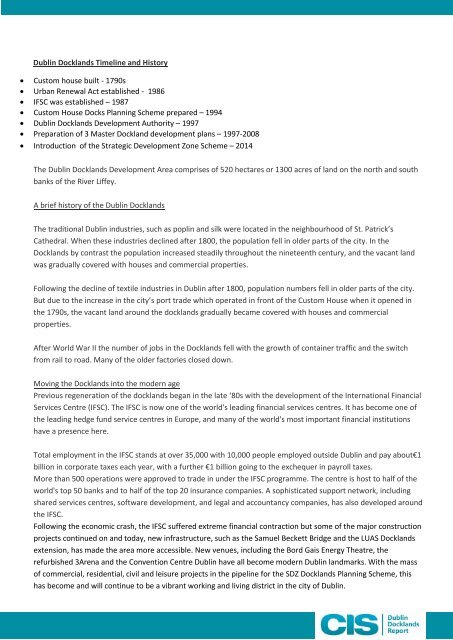Dublin Docklands Report
1QCQLyd
1QCQLyd
Create successful ePaper yourself
Turn your PDF publications into a flip-book with our unique Google optimized e-Paper software.
<strong>Dublin</strong> <strong>Docklands</strong> Timeline and History<br />
• Custom house built - 1790s<br />
• Urban Renewal Act established - 1986<br />
• IFSC was established – 1987<br />
• Custom House Docks Planning Scheme prepared – 1994<br />
• <strong>Dublin</strong> <strong>Docklands</strong> Development Authority – 1997<br />
• Preparation of 3 Master Dockland development plans – 1997-2008<br />
• Introduction of the Strategic Development Zone Scheme – 2014<br />
The <strong>Dublin</strong> <strong>Docklands</strong> Development Area comprises of 520 hectares or 1300 acres of land on the north and south<br />
banks of the River Liffey.<br />
A brief history of the <strong>Dublin</strong> <strong>Docklands</strong><br />
The traditional <strong>Dublin</strong> industries, such as poplin and silk were located in the neighbourhood of St. Patrick’s<br />
Cathedral. When these industries declined after 1800, the population fell in older parts of the city. In the<br />
<strong>Docklands</strong> by contrast the population increased steadily throughout the nineteenth century, and the vacant land<br />
was gradually covered with houses and commercial properties.<br />
Following the decline of textile industries in <strong>Dublin</strong> after 1800, population numbers fell in older parts of the city.<br />
But due to the increase in the city’s port trade which operated in front of the Custom House when it opened in<br />
the 1790s, the vacant land around the docklands gradually became covered with houses and commercial<br />
properties.<br />
After World War II the number of jobs in the <strong>Docklands</strong> fell with the growth of container traffic and the switch<br />
from rail to road. Many of the older factories closed down.<br />
Moving the <strong>Docklands</strong> into the modern age<br />
Previous regeneration of the docklands began in the late ‘80s with the development of the International Financial<br />
Services Centre (IFSC). The IFSC is now one of the world's leading financial services centres. It has become one of<br />
the leading hedge fund service centres in Europe, and many of the world's most important financial institutions<br />
have a presence here.<br />
Total employment in the IFSC stands at over 35,000 with 10,000 people employed outside <strong>Dublin</strong> and pay about€1<br />
billion in corporate taxes each year, with a further €1 billion going to the exchequer in payroll taxes.<br />
More than 500 operations were approved to trade in under the IFSC programme. The centre is host to half of the<br />
world's top 50 banks and to half of the top 20 insurance companies. A sophisticated support network, including<br />
shared services centres, software development, and legal and accountancy companies, has also developed around<br />
the IFSC.<br />
Following the economic crash, the IFSC suffered extreme financial contraction but some of the major construction<br />
projects continued on and today, new infrastructure, such as the Samuel Beckett Bridge and the LUAS <strong>Docklands</strong><br />
extension, has made the area more accessible. New venues, including the Bord Gais Energy Theatre, the<br />
refurbished 3Arena and the Convention Centre <strong>Dublin</strong> have all become modern <strong>Dublin</strong> landmarks. With the mass<br />
of commercial, residential, civil and leisure projects in the pipeline for the SDZ <strong>Docklands</strong> Planning Scheme, this<br />
has become and will continue to be a vibrant working and living district in the city of <strong>Dublin</strong>.


